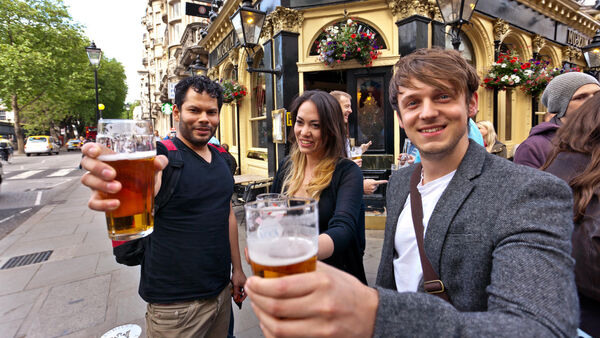London: Britain’s Pub Hub
By Rick Steves
Most new visitors to London are amazed at how "un-English" it feels. Chinese take-outs outnumber fish-and-chip shops, many hotels are run by people with a foreign ancestry, and curry is the "local" specialty. But there's at least one place in London that's straight out of jolly olde England — the pub.
The pub is the heart of the people's England, where all manner of folks have, for generations, found their respite from work and a home-away-from-home. England's classic pubs are national treasures, with great cultural value and rich history, not to mention good beer and grub.
Crawling between London's classic pubs is more than a tipsy night out — it's bona fide sightseeing. The city's most characteristic pubs range from places where Shakespeare could have made merry to classy 20th-century revivals. Each offer a glimpse — and a taste — of traditional English culture.
Their odd names can go back hundreds of years. Because so many medieval pub-goers were illiterate, pubs were simply named for the picture hung outside (e.g., The Crooked Stick, The Queen's Arms — meaning her coat of arms).
The Golden Age for pub-building was in the late Victorian era (c. 1880–1905), when pubs were independently owned and land prices were high enough to make it worthwhile to invest in fixing up pubs. The politics were pro-pub as well: Conservatives, backed by Big Beer, were in, and temperance-minded Liberals were out.
Especially in class-conscious Victorian times, traditional pubs were divided into sections by elaborate screens (now mostly gone), allowing the wealthy to drink in a more refined setting, while commoners congregated on the pub's rougher side. These were really "public houses," featuring nooks (snugs) for groups and clubs to meet, friends and lovers to rendezvous, and families to get out of the house at night.
Historic pubs still dot the London cityscape. The only place to see the very oldest-style tavern in the "domestic tradition" is at Ye Olde Cheshire Cheese (145 Fleet Street), which was rebuilt in 1667 (after the Great Fire) from a 16th-century tavern. I like to imagine this mazelike place, with three separate bars, in the pre-Victorian era: With no bar, drinkers gathered around the fireplaces, while tap boys shuttled tankards up from the cellar. (This was long before barroom taps were connected to casks in the cellar. Oh, and don't say "keg" — that's a gassy modern thing.)
Late-Victorian pubs are more common, such as the lovingly restored 1897 Princess Louise (208 High Holborn). These places are fancy, often with heavy embossed wallpaper ceilings, decorative tile work, fine-etched glass, ornate carved stillions (the big central hutch for storing bottles and glass), and even urinals equipped with a place to set your glass.
London's best Art Nouveau pub is The Black Friar (c. 1900–1915), with fine carved capitals, lamp holders, and quirky phrases worked into the decor (174 Queen Victoria Street).
The "former-bank pubs" represent a more modern trend in pub-building. As banks increasingly go electronic, they're moving out of lavish, high-rent old buildings. Many of these former banks are being refitted as pubs with elegant bars and freestanding stillions, which provide a fine centerpiece. Three such pubs are The Old Bank of England (194 Fleet Street), The Jugged Hare (172 Vauxhall Bridge Road), and The Counting House (50 Cornhill).
Pub grub is better than it sounds, and getting tastier every year. Pubs often serve traditional dishes, such as "bangers and mash" (sausages and mashed potatoes) and roast beef with Yorkshire pudding, but you're just as likely to find pasta, curried dishes, and quiche on the menu.
And, of course, there's the number-one reason people have always flocked to pubs: beer — and the British take great pride in their brews. Many Brits think that drinking beer cold and carbonated, as Americans do, ruins the taste. Most pubs will have lagers (cold, refreshing, American-style beer), ales (amber-colored, cellar-temperature beer), bitters (hop-flavored ale, perhaps the most typical British beer), and stouts (dark and somewhat bitter, like Guinness). At pubs, long-handled pulls are used to pull the traditional, rich-flavored "real ales" up from the cellar. These are the connoisseur's favorites: fermented naturally, varying from sweet to bitter, often with a hoppy or nutty flavor. Notice the fun names. Short-handled pulls at the bar mean colder, fizzier, mass-produced, and less interesting keg beers. Mild beers are sweeter, with a creamy malt flavoring. Irish cream ale is a smooth, sweet experience. Try the draft cider (sweet or dry)...carefully.
Spend some time in any of these pubs today and you'll have your finger on the pulse of London. These cozy hang-outs are an extended living room, where locals and travelers alike can eat, drink, get out of the rain, watch a sporting event, and make new friends. Like in days past, people go to a pub to be social. If that's your aim, stick by the bar (rather than a table) and people will assume you're in the mood to talk. Go pubbing in the evening for a lively time, or drop by during the quiet late morning (from 11:00), when the pub is empty and filled with memories.


